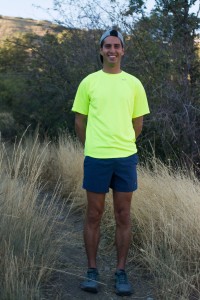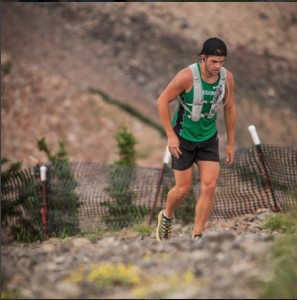Some students run for the track team. Others run to class. And some students run 100-mile races. For BYU students Andy Tygard and Cameron Adamson, running ultra-marathons is a challenging passion that requires extreme discipline.
Tygard has been training since April for his first ultra-marathon — a 100-mile race scheduled for Sept. 18.

“I came home from my mission and started running just to stay in shape,” Tygard said. “But something clicked and I started running longer and longer until all of a sudden I was running 15-mile-long runs and found out I was pretty decent at it.”
Tygard has an unconventional history of racing — he’s never even ran a marathon. He started running half-marathons then jumped to two 50-mile races. He missed a turn in his last race and ended up running more than 50 miles, which led him to believe he had a shot at the 100-mile distance.
Tygard heard many negative opinions about ultra-marathons, but he decided to research them for himself. “When people talk to me about ultra-marathons they say, ‘That’s terrible on your knees, that’s not even good for you,’ but every single thing that I have read, and the people who I see in these races, look and say the complete opposite.”
Pepper Murray is an orthopedic surgeon at Mountain Orthopedics. Murray said the effects these races have really depend on one’s body makeup. Some people can successfully do it but it takes dedication, education and training.
He explained that running loads joints with four times a person’s body weight. “There are wear issues from that type of involvement. It can be detrimental, but ultimately you choose how you wear your body out in the end,” Murray said.
Murray said he wouldn’t prohibit this type of racing, but people should know that they may wear themselves out and “pay the price eventually.” He said people all have different quality body parts — some people are born with high-quality cartilage that can use it without much consequence. “Others of us are blessed with the blue-line Kmart special cartilage that will wear out in our 20s if we do those high-level activities. It’s unpredictable who is going to wear out and who is not,” he said.

Tygard’s ultra-marathon is called the Run Rabbit Run, a 100-miler through Colorado mountain trails. “The terrain is like running Timp a bunch of times. It’s going to be insane,” Tygard said. “The first three to four miles we go from 6,500 to 10,500 feet in elevation.”
The race begins at 8 a.m. and lasts 36 hours. There are aid stations along the way, but the stations must be reached at a certain cut-off time or the runner will be disqualified.
“It’s still a pretty small group of people who run the races, but once you’ve done one, you can’t stop. I have a friend who has run five in the past three years,” Tygard said. That friend is Cameron Adamson.
Adamson is a BYU history major from Washington who also started running after his mission.
“You don’t have enough time to get in all the exercise that you want, so I was really motivated after I got home to really get into it,” Adamson said. Initially interested in running marathons, Adamson qualified for the Boston Marathon twice.
But he became disenchanted with the race as it lost its challenge.
Adamson found ultra-running “almost by accident,” and Adamson claims it changed his life. He has finished seven ultra-marathons, three of which were 100-miles long. Adamson is hooked.
“Relatively speaking, it’s a new sport. The first one was in the ’70s,” Adamson said. “Compare that to the 100 years they’ve been doing the Boston Marathon. It’s just starting to gain traction. As the marathon has increased, people are like me: they’ve done the marathon, it doesn’t pose a challenge for them anymore, and now we’re moving into something that poses a challenge for us.”
Having never run on trails before, Adamson’s first attempt was quite dramatic. He ultimately had to be rescued off the top of a mountain after quitting at mile 72. But he had to try again.

“The 100-mile distance never gets easy, it’s never something that’s a given,” Adamson said. “(During) a marathon you are out there for three to four hours, but when you’re out there for 20 to 30 hours, anything can happen … You can get hypothermia, you can get heat stroke, you can get hallucinations … all of these things I’ve had. There’s just a wide range of things that can go wrong. All you can do is just mitigate the risks and the problems.”
With such a long race, being sleep deprived can be one of the most difficult things to face.
“The last one I did, I was falling asleep as I was running,” Adamson said. “I put my water bottle down as a pillow and slept on the side of the trail and was actually laying in poison oak and didn’t realize it. So after the race I had all these poison oak marks up my back. It was kind of funny.”
The mental recovery is another tough aspect of races. It takes Adamson a month to get back to “normal” but physically he can be back to running by the next week.
“There’s nothing inherently damaging about the race on your body at the average level,” Adamson said. “Humans can do this absolutely. There are 200-, 500-mile races now, and people are OK.”

Adamson said the hardest race he ever ran was a 105-miler in Colorado, when freezing night temperatures and wearing only a down jacket did not equal the healthiest running conditions.
“I was almost hypothermic. But then in the day time, I was roasting in the sun and I got heat stroke,” Adamson said. “I started hallucinating, and a few times I thought there was a border collie running with me. It was actually my hand — I was seeing it in my peripheral. I imagined this pile of rocks to be the next aid station, and it was nothing.”
Adamson said that race was the most rewarding and memorable because it was the most difficult.
So what’s next for this crazed runner? Adamson said he is looking forward to a few 100-mile races he has yet to run. “Two-hundred-mile races intrigue me, but that’s all I can say right now. I can’t imagine running 100 miles and just being at the halfway point, but I could see myself trying one in the future. I kind of shudder thinking about it … but maybe in five years.”




